As mentioned earlier, this is not a comprehensive account of my family roots. There are far too many stories of grandparents, aunts, uncles, and other relatives who have preceded us to include all of them on this website.
Below are interesting stories from select branches off our family tree from the 1700s, 1800s, and early 1900s.
James J. Moore (1782 – 1841)
Searching for James J. Moore’s Father
Moore Family and Slavery (1820 – 1860)
John Mike Borders Moore (1814 – 1898)
John Hardin Moore (1874 – 1916)
Birdie McCowen Vandigriff Moore (1880 – 1969)
Samuel Shupe (1799 – 1844)
Charles Wesley Dollahite (1824 – 1869)
Elizabeth Dollahite Hale (1861 – 1955)
Dr. Charles William Bufkin (1882 – 1927)
James Sanford Love (1877 – 1957)
Relatives in Wars (Revolutionary War to World War II)
James J. Moore
A deep dig into United States Census records unearthed the oldest Moore we can trace, James J. Moore. He was born 1782 in South Carolina and died 1841 in Jackson, GA.
James J. Moore is the father of John Mike Borders Moore (born 1814). John’s son, William James Moore (born 1843), is the father of John Hardin Moore (born 1874). John Hardin is the father of William Alvin Moore, Sr. (born 1903) who is father of William Alvin Moore, Jr. (born 1936).
Finding James wasn’t easy.
The 1860 Census record for John Mike Borders Moore revealed a clue about James. “Phebe” Moore, age 70, was listed as a household member for John’s family. Naturally, we can assume Phebe is John’s mother.
The 1820 Census report for James Moore confirms this assumption. Phebe’s name is not listed in this report. However, it lists one female between the ages of 24 and 45 living in the house. (That’s Phebe.)
A family tree on Ancestry.com for a Pheobe Borders connects her to James J. Moore. (Phoebe is spelled “Phebe” in almost every record found online.)
James and Phebe had seven children and in 1830, they were living in Walton County, Georgia.
Searching for James J. Moore’s Father
NOTE: I began working with a genealogist in the spring of 2014 with the goal of extending the Moore family paternal line past James J. Moore. From digging into deeds, wills, tax records, and marriage licenses, a factual narrative about James’ life was pieced together. Unfortunately, the identity of James’s father is not yet known. More research is needed to extend the paternal line past James J. Moore.
This is the incomplete story of finding the Father to James J. Moore.
James J. Moore’s will was written on October 9, 1840 and probated in Walton County, Georgia on January 6, 1841. (He most likely died a few days before the probate date.)
In his will he listed seven children: five daughters (Cynthia Roberts, Jane Brice, Mary, Rachel, Nancy) and two sons (John M.B., William A.J.) His wife, Phoebe (Phebe), and son John were appointed to be the executors of James’ will.
To his wife Phebe, James left: 100 acres of land, along with the house, slaves, household furniture, kitchen furniture and livestock. The remainder of his estate was to be sold and the money divided equally between his children.
It is important to note John M.B. Moore was appointed an executor of James’ will. This proves with absolute certainty John Mike Borders Moore is the son of James J. Moore. With this knowledge in hand, the genealogist began digging deeper into records with the hopes of finding James’ father.
James and Phebe received their marriage license on December 1, 1806 in Jackson County, Georgia. They were married for 35 years.
Tax records from 1809 provided valuable insight into James J. Moore. He was listed as a resident of Captain Thomas Black’s district and was paying taxes on 118 acres of land on between Sandy Creek and Walnut Creek in Jackson County, GA. Also listed in the 1809 tax records were William Moore and Alexander Moore. Based upon 1809 tax records, it is clear James, William, and Alexander all owned adjoining tracts on Sandy Creek.
On May 20, 1816, Alexander Moore sold 33-1/3 acres of land to James J. Moore. This acreage was one-third of a 94-acre tract that had originally been sold by William Moore to James, Alexander, and a Joseph J. Moore on October 18, 1802. It isn’t clear whether the James listed in the 1802 transaction is the same James J. Moore from the 1816 transaction because the “James” buying the land from William did not have a middle initial.
Because William, James, and Alexander were involved in each other’s numerous land transactions as sellers, purchasers, and witnesses, this led the genealogist to better define their family relationship. Could William be the father of James and Alexander? Perhaps Williams, James and Alexander were brothers. These are questions the genealogist sought to answer.
William was at least 15 years older than James so it is possible William Moore could be James’ father. However, William’s will (written on May 22, 1835 and probated on September 7, 1835) failed to show James had any claim to the estate of William. James did; however, serve as a witness to the will. And in an 1842 probate document from William’s estate, it mentioned James J. Moore as deceased. These pieces of information further link together James with William.
According to the 1820 census, Alexander Moore had moved to Athens in Clarke County, GA and was between the ages of 24 and 44, placing him in the right age range to be James’ brother.
With so many Moores clustered together in Jackson and Clarke Counties and with common names repeated, it becomes an extremely mind-bending and time-consuming challenge to identify the right family members connected to James J. Moore.
Another example that illustrates this challenge involves the marriage of James and Phebe Moore. The Justice of the Peace who presided over the marriage between James and Phebe was William Moore. This same William Moore, J.P. served as a witness to various land deals involving James J. Moore. This is a different William Moore than the one who is most likely and older brother of James.
The 1805 Georgia Land Lottery records from Jackson County add even more naming confusion. This land lottery document showed there were 3 residents named James Moore, 2 named John Moore, 2 named William Moore, and 2 named Michael Moore.
The genealogist found a land deed from July 15, 1793 that offered hope in clarifying the right family members connected to James J. Moore.
This land deeds revealed a “William Moore” purchased a 287 1/2 –acre tract of land on Sandy Creek in Jackson County, GA. The seller, Daniel Matthews, and the purchaser, William Moore, were both listed as residents of Spartanburg County, South Carolina. Subsequent land transactions revealed a “William Moore, Sr.” sold 184 acres of land on Sandy Creek to a “William Moore, Jr.” on March 27, 1800.
While searching land records in Spartanburg County, the genealogist hit another naming roadblock—two distinct men named William Moore. There was a William Moore with a wife named Elizabeth living in Spartanburg until about 1800. But, the other William Moore listed in land records was shown to be living in Jackson County, GA in the 1790s.
Land records during this time in both Spartanburg County and Jackson County all list numerous people named William Moore. At times, a “William Moore, Sr.” appears on records. Other times, it’s a “William Moore, Jr.” or just “William Moore.” Trying to separate out who is who and who did what when becomes a herculean task.
Extending the paternal Moore family line past James J. Moore is still unresolved. The genealogist told me, “The large number of records available for this family can be considered a blessing and a curse. The fact that there are three men named William Moore, and multiple men named James Moore (as well as other duplications of given names), only complicates matters.”
With more research and the drawing of a complicated land deed/grant map of Moores in Jackson County, the genealogist remains optimistic the paternal Moore family line can be extended past James J. Moore. However, that research will have to wait for another time.
James J. Moore is Al’s third great grandfather.
Al’s fourth great grandfather is still unknown.
Further Learning:
- James J. Moore Will (1840) | (.pdf)
- Phebe Moore probate papers (1862) | (.pdf)
- 1820 Census Report for James J. Moore | (.jpg)
- 1830 Census Report for James J. Moore | (.jpg)
Moore Family and Slavery
If you were a farmer living in the South, or the North, from the 1600s through 1862, you owned slaves. The Moore family were farmers and the disturbing truth is, the family owned slaves.
Minimal records of slaves were kept, if any. When kept, names were almost always left off the records. Slaves were simply listed by age, sex, and color.
The 1820 Census report shows James J. Moore owned 5 slaves. In 1830, he owned 14 slaves.
John Mike Borders Moore owned 10 slaves in 1850 and in 1860, he owned 21 slaves. Phebe Moore, at age 70, owned 3 slaves in 1860.
The Emancipation Proclamation was signed 1862, giving slaves their freedom and forever changing the American landscape.
In the first Census after the ending of slavery in 1870, William James Moore was a 27 year-old farmer, husband, and father to a three year-old daughter. Besides listing his wife and daughter on the 1870 Census, it’s interesting to note he also lists three servants living in his household: Jenkins Moore (age 8, domestic servant), Blake Crow (farm worker), and Ella Cooper (farm worker).
Further Learning:
John Mike Borders Moore
John Mike Borders Moore was born 1814 in Walton County, Georgia, about 45 miles east of Atlanta. Very little is known about John. We do know he married Sallie (Sarah) Magnos Smith and they had two children, Mary J. (born 1838) and William James (born 1843). (Records indicate Mary J. Moore died at age 11 in 1849.)
We do know the Moore family home was burned in the fall of 1876. According to a transcription from The Daily Constitution (Oct. 26, 1876), “The dwelling house and out buildings on the place of Mr. John M B Moore, of Walton county were burned recently.”
My DNA test revealed something interesting about John Mike Borders Moore.
Ancestry.com will match people together who have similar DNA results. These matches range from “Very Close” (within 6 generations) to “Very Distant” (25 or more generations).
James Arthur Burnett is a “Very Close” DNA match to me. He was born in the 1940s and lives in Columbus, OH. James is an African-American with known family roots in Alabama and Arkansas.
African-Americans have a very difficult time tracing their family histories before 1870 because recordkeeping of slaves is inconsistent and incomplete. The first United States Census to include African-Americans happened in 1870, eight years after the Emancipation Proclamation gave slaves their freedom.
I contacted James Burnett after finding out we are connected through our DNA. James and I talked and surmised John Mike Borders Moore fathered a son with a slave. At some point the son was either sold or taken to Arkansas. John’s son went on to father James’ great grandmother, Caroline.
James has always suspected his family had recent European DNA because they are light-skinned and have less than kinky hair. He went on to tell me this news was “mind blowing” because very few African-Americans can identify where their European blood came from.
Like with all answers found from digging through one’s ancestry, this answer opens up more questions. Perhaps with advances in DNA technology, more questions will answered to better explain the DNA linkage between the Moore family of Texas and the Burnett family of Ohio.
John Mike Borders Moore is Al’s second great grandfather.
Further Learning:
Smith Family Cemetery
On the outskirts of Monroe, Georgia, is a small family cemetery belonging to Charles H. Smith. Charles and his wife, Susan, had two children— C.H. Smith and Sallie Magnos Smith. Sallie married John Mike Borders Moore and they had four children, including William James Moore.
The Smith Family Cemetery is where John, Sallie, and their children are buried. As the video below shows, the small cemetery is as beautiful a place anyone could hope to be buried.
John Hardin Moore
Birdie Moore was at home waiting for her husband, John, to accompany her to visit a relative who had recently passed away. It was late in the workday, around 8 o’clock, when Birdie phoned her husband. They talked for a short while and then… sudden silence.
Later, Birdie said, “I knew something had happened to [him], when his conversation was so suddenly cut off. He never had ended a telephone conversation with me, without telling me goodbye.”
John Moore was murdered. Shot in the back. He died almost immediately, while his murderer escaped.
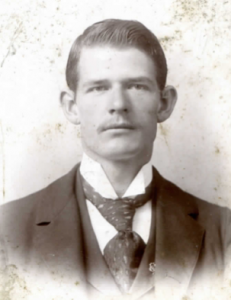 John Hardin Moore was born on September 18, 1874, in Watkinsville, Georgia. He was the third child born to William James Moore and Emma Haygood Moore. His oldest sister, Mary Jane, was born in 1866 and another sister, Sallie, was born in 1872 but died in 1879.
John Hardin Moore was born on September 18, 1874, in Watkinsville, Georgia. He was the third child born to William James Moore and Emma Haygood Moore. His oldest sister, Mary Jane, was born in 1866 and another sister, Sallie, was born in 1872 but died in 1879.
John married Birdie McCowen Vandergriff on June 5, 1901. The newlyweds lived in Atlanta, Georgia.
John, in his mid-twenties, worked as a coal, wood, and ice dealer. He sold coal during the cold months, ice during the warm months, and wood all year long. His business flourished and by 1916, he employed 50 people.
John Moore was a respected businessman and active in the Atlanta community, having been a founding member of the Lebanon Masonic Lodge #655.
In the summer of 1916, John hired Frank Hugle, an African-American, to be his driver. Frank was a good friend of Will Miles, who had spent time in prison and had numerous run-ins with the police.
On the early evening of Tuesday, October 3, 1916, Frank and Will were reportedly seen drinking and talking. Will asked Frank if Mr. Moore was still carrying a big roll of money, approximately $300. Frank apparently confirmed Mr. Moore was still carrying the money.
It’s reported Will Miles went home, changed his clothes, and grabbed a gun.
Around 8 o’clock that Tuesday night, Will entered John Moore’s office at 129 McDaniel Street. John was talking on the telephone to his wife when Will fired one shot. The bullet entered through John’s back, between his shoulders, and exited through his neck.
News of the murder spread fast. Family friend, Robert Smith, quickly told Birdie the horrible news. Birdie, along with her 12-year old son, Alvin, rushed to the scene in a car. It was too late. John Hardin Moore was dead at the age of 42.
The police investigation of the murder began immediately. A few African-American workers were still in Mr. Moore’s coal and wood yard, they were questioned but none arrested.
Acting upon eyewitness accounts, police detectives identified Will Miles as the prime suspect. Police conducted a search of Will’s home on that Tuesday night and found a revolver, wrapped in a shirt with one bullet missing.
While being interrogated by the police, Will Miles said he didn’t pull the trigger but instead, Frank Hugle was the murderer. Frank was also arrested.
Miles frequently changed his story as to what happened. Some days he would confess to being the murderer and other days he proclaimed his innocence. Hugle proclaimed his innocence throughout as an accomplice to the murder. Court proceedings dragged on for weeks and months.
Speaking to Judge Ben Hill, Will Miles said, “Judge, they just beat me up at the police station and made me say what I did — I wasn’t at Mr. Moore’s office the night he was killed, and didn’t have nothing to do with it.”
Judge Hill replied by telling Will the evidence against him was over whelming and there was no doubt of his guilt.
Will Miles was hanged for the murder of John Moore in the spring of 1917.
After various stays of execution from the courts and from the Governor of Georgia, Frank Hugle was hanged for his role in the murder on June 22, 1917.
John Moore willed his estate, worth $50,000, to his wife and two children. Birdie Vandergriff Moore never remarried. Their son, Alvin Moore, became a successful business executive with Mississippi Power & Light and married Eloise Elizabeth Love. Their daughter, Helen Moore, married Claude Grizzard, a successful advertising businessman in Atlanta, GA.
John Hardin Moore is the grandfather of Al Moore.
Further Learning:
- JH Moore Wood and Coal Yard | photo (.jpg)
- John Hardin Moore office and desk | photo (.jpg)
- Newspaper articles on his murder (.pdf)
Birdie McCowen Vandigriff Moore
Obituary published late October 1969 | Atlanta Journal Constitution | (.pdf download)
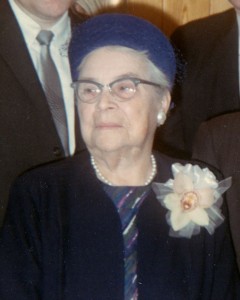 Mrs. John Hardin Moore was born Birdie McCowen Vandigriff, Feb. 22, 1880 in Locus Grove, GA. She died Oct. 21, 1969.
Mrs. John Hardin Moore was born Birdie McCowen Vandigriff, Feb. 22, 1880 in Locus Grove, GA. She died Oct. 21, 1969.
After graduating from the State Teacher’s College in Athens, she taught in the Lithonia Public School. She was married in 1902, but was tragically widowed in 1916.
Mrs. Moore was one of the 39 charter members of Atlanta’s Haygood Memorial Methodist Church, organized in 1926. She became the first president of the Missionary Society. Also, she was appointed chairman of the commission on missions, a position she held for the remaining years of her life. She sponsored many successful drives for missionary funds, and led Haygood Church to a position of leadership in the mission work of the North Georgia Conference.
Mrs. Moore was deeply interested in the education of Indian children n Bolivia, and for several years she sponsored a fund for this purpose as a mission special over and above Haygood’s missionary budget.
Since the early days of the church, she had been an outstanding member of the board of stewards. Largely, it was due to her enthusiasm and leadership that the “Builder’s Club” of Haygood Church became one of the largest in the North Georgia Conference.
“Miss Birdie,” as she was affectionately known by her many friends, was devoted to her church; and in return, she was sincerely loved and appreciated.
She will be greatly missed by her family and friends, but her Christian strength and influence will live on.
Mrs. Moore is survived by a daughter, Mrs. Claude T. (Helen) Grizzard Jr.; five grandchildren, eleven great-grandchildren and a sister, Miss Gussie Vandigriff. Her son was the late Alvin Moore.
Funeral services were conducted by her pastor, the Rev. James M Moore Jr., with internment in Atlanta’s Westview Cemetery.
“Green be the turf above thee.
Friend of my better days!
None knew thee but to love thee,
Nor named thee but to praise.”
Birdie McCowen Vandigriff Moore is the grandmother of Al Moore.
Further Learning:
- Tribute Obituary | (.pdf)
- Tribute Poem written by Mrs. Tigner Wiggens | (.pdf)
- Birdie Moore in her early 20s | (.jpg)
- Birdie Moore in her early 30s | (.jpg)
- Birdie Moore in April of 1958 | (.jpg)
Helen Moore Grizzard remembers her Father & Mother
The following is an edited version of an Oral History that Helen Grizzard gave to a student in late 1985.
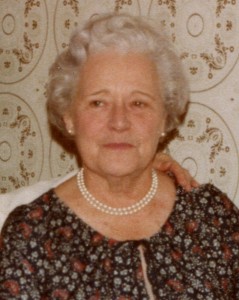 I (Helen Moore Grizzard) was born February 19, 1910 and I had the usual childhood. I had an older brother, seven years older, and a mother and a father. I was a spoiled brat! We lived in a big house on Georgia Avenue & Central and had lots of coming and going relatives.
I (Helen Moore Grizzard) was born February 19, 1910 and I had the usual childhood. I had an older brother, seven years older, and a mother and a father. I was a spoiled brat! We lived in a big house on Georgia Avenue & Central and had lots of coming and going relatives.
Then tragedy struck on October 3, 1916. My father was murdered.
He (John Hardin Moore) was in the coal and wood business and had Negro drivers of his wagons and mules where he delivered coal and wood. He dickered in real estate, too. This particular night was cool and he was working late. It was known among the drivers that he had money on him that night. So, two Negroes were going to rob him and they were frightened by a man that lived next door to his office.
This man, Robert Smith, was a friend of my father’s. Robert said, “That doesn’t look right.” So he started walking around and then, right after him, his wife was coming around. But, in doing that, he frightened the Negroes and they shot my Father. It hit the deadly so-called jugular vein and my Father died immediately.
At that time, one of the horrors of the thing—he was talking to my Mother on the telephone and they were making plans to go an call on some of the relatives in south Atlanta that had a death in the family. My Mother heard the shot and knew that something awful had happened.
This murder was a horrible thing. My Father was prominent in the community and his family was. He was a Mason and my family had been Methodists for years. We lived across the street from the church.
The public just became, well, just furious at this thing. Everybody was afraid that there’d be a lynching. So the people in authority of Fulton County really got busy and they had those Negroes before the night was over.
To continue, the Negroes were both hung. There was a lot about it in the paper. This was the first case, I have been told, of the betterment of the Negroes race relations. I have also been told that Colgate sent money in here to help these Negroes with trials.
At that time, women didn’t live alone with two children, regardless of how many servants she had. So, my Grandmother, Grandfather, and an old maid Aunt moved in with us. We had plenty of room, but it made a kind of, I guess you’d say, an unbalanced home. There were old folks, the Grandparents, then my Mother and her sister, and then, children.
But we were all happy and my Mother kept that house on an even keel. Now that I look back on it, I don’t see how she did it. But she did! She had that kind of religion and faith.
The minute my Father was killed, she took over his affairs. She never went to work. He had property, mostly Negro rental property. She collected the money; she had the steps built where they fell down, or the chimney, or that kind of thing.
We had a good living. I had everything any girl would ever want.
My mother lived until 1969. She was 89 and she had a horror of living in a nursing home. Do you know I had a date with her to pick her up to go vote and I found her dead in bed. She had had her lunch, walked around her yard, which she did on pretty days. I just thought my Mother, at 89, was hale and hearty, and would live any number of years more.
Helen is the daughter of John and Birdie Moore. She died on July 12, 1996.
Helen Moore Grizzard is the Aunt of Al Moore.
Further Learning:
- Oral History Interview with Helen Grizzard | 9 pages [edited version] (.pdf)
Samuel Shupe
For six weeks in the fall of 1835, an outnumbered all-volunteer Texas army fought for control of San Antonio. The resilient 600-strong Texan army, led by Stephen F. Austin, battled against Mexican General Martin Perfecto de Cos’s Mexican army of 1,200 soldiers.
The Mexican army eventually surrendered and retreated to the Rio Grande. The Texans celebrated victory knowing the Mexican army was weakened. 150 Mexicans were either killed, wounded, or captured in the battle known as the Siege of Bexar. Only 35 Texans were either killed, wounded, or captured in the siege.
Members of the volunteer Texas army each received 320 acres of land for their hard-earned victory. Samuel Shupe, a 36-year old Texas army volunteer, added this land grant to his growing Texas acreage.
Samuel was born 1799 in Reading, Pennsylvania, to Quaker parents. Legend says he ran away from home at the age of nine. In 1822 he traveled down the Mississippi River headed for Kerrville, TX.
He resurfaced in 1827 as a new colonist in the Dewitt Colony, near Gonzalez, TX. Samuel, age 28, arrived in Texas with 14 head of cattle and received, as a new colonist, 1,107 acres of land just south of Lockhart, TX.
Unrest between the Mexican government and Texan settlers had been percolating for years and erupted in a short war, known as the Texas Revolution. The first clash between troops occurred on October 2, 1835 at the Battle of Gonzales. Texans claimed victory over the Mexicans in this first battle for their independence.
Samuel Shupe’s home and acreage was less than 20 miles from Gonzales. On October 3, 1835, Shupe volunteered to fight for Texas independence.
Shupe’s first duty took place from October 11 through December 11, 1835 at the Seige of Bexar, where the Texan militia defeated the Mexican army.
Four months later, 2,400 Mexican soldiers, under Santa Anna’s leadership, decimated a small Texas army at the Battle of the Alamo. Every Texan was killed at the Alamo. Samuel Shupe did not participate in this battle.
The final conflict in the Texas Revolution took place at the Battle of San Jacinto on April 21, 1836. Shupe was at San Jacinto in the 5th Infantry Company, 2nd Regiment under Captain Thomas McIntire.
The Texan militia surprise attacked the Mexican army at San Jacinto. It was hardly a contest. Only nine Texans were killed and 30 were wounded in the battle. 630 Mexicans were killed, 208 wounded, and 703 were captured.
Texas fought for and won its independence from Mexico and the Republic of Texas was born.
For his efforts in the Battle of San Jacinto and service in the Texas army, Samuel Shupe received nearly 1,000 acres of land.
Samuel Shupe, now aged 37, returned to his land turned his attention to finding a wife and starting a family.
Patience Wells Sapp, a widower, moved to Texas in 1837 from Missouri with her young son and her cousin James Kerr. As the head of her household, she was granted 1,280 acres of land in Lavaca County.
Samuel Shupe and Patience Wells were married in July of 1838. They had two daughters and together, they had a sizeable acreage of Texas land.
Patience’s cousin, James Kerr, made a name for himself as a successful businessman in Central Texas. Kerrville and Kerr County were named after James Kerr.
In 1847, Samuel Shupe became ill. He traveled to New Orleans for medical treatment but died en route due to his illness.
Patience remarried in 1849 to Charles Simons and died in Lockhart, Texas in 1883. Her daughters, Zerilda Ruth Shupe and Elizabeth Shupe both married and continued to live in Texas to raise their families. The sizeable acreage owned by the Shupe family dwindled over the years as land was sold for money to offset living costs incurred by the family.
Samuel Shupe is Glenna’s second great grandfather.
sources:
- Samuel Shupe family bio written by Will Ross (.pdf)
- Dewitt Colonists 1828 Biographical Sketches (online link)
- Samuel Shupe description (online link)
Charles Wesley Dollahite
On a blustery and cold afternoon in the fall of 1869, Charles Wesley Dollahite, a schoolteacher, readied his horse for the trek back home, including a gift of butchered meat. Charles’ son, Sam Shupe Dollahite, was also preparing his horse for the trip home. Father and son rode away from the schoolyard situated near Johnson City in the Texas Hill Country.
They hadn’t gone far when they were attacked by a group of Comanche Indians.
Charles fired two bullets from his gun before an arrow pierced his wrist. He turned his attention to protecting Sam from the Indians. Charles fell to ground and was killed. 200 yards away, a poisoned arrow struck Sam in the back.
The Comanches took the butchered meat and added the two horses to their collection of other horses captured from their recent raids.
Back at the Dollahite home, Mrs. Zerilda Dollahite, along with her daughters, was preparing dinner and waiting for her husband and son to arrive. (The Dollahite daughters stayed home that day because of the inclement weather.)
Word of the murder spread fast and instead of seeing her husband and son returning home, Zerilda saw Reverend Rucker riding up to her house. Zerilda and her children were told of the devastating news.
It’s believed this was the last recorded Indian attack in the Texas Hill Country.
Charles Wesley Dollahite is Glenna’s great grandfather.
Sam Shupe Dollahite is Glenna’s grand uncle.
Artist Jack Bryant depicted this incident in a commissioned piece called, DOUBLE FALL. Below is a scanned copy of the painting.
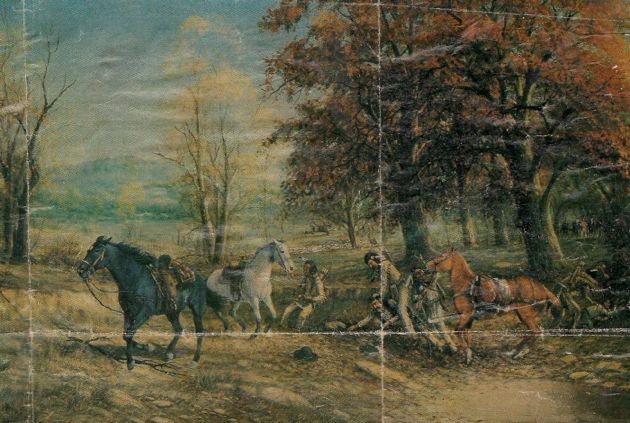
Round Mountain Cemetery | Blanco County, Texas (video from April 6, 2012)
Elizabeth Dollahite Hale
Before her marriage to Thomas J. Hale, Elizabeth Dollahite (1861-1955) was a schoolteacher. However, in the years she spent as wife and mother, her teacher’s certificate expired.
An accidental death to Thomas left Elizabeth alone to support and raise their seven children. Medical bills were piling up and work was left undone on their family farm. Elizabeth decided to return to the teaching profession to support her family.
She became certified again and then went looking for work as a schoolteacher. Elizabeth found a school in need of a teacher eight miles away from her farm that would pay her forty dollars a month.
Elizabeth, along with her son, Claude, took the family wagon to the creek to wash it the day before they were to begin the eight-mile journey to the school so she could interview for the position.
Heavy rains fells on the Texas Hill Country that night, flooding the creek that separated the school from the main road.
The next morning, Elizabeth and Claude began riding their wagon to the school only to be stopped at the overflowing creek. Three men were on the creek bank waiting for the waters to subside before they crossed. These men were also heading to the school for the open teacher position.
Determined, Elizabeth snapped the reins of her horses and drove through the flooded creek and arrived safely on the other side.
The school trustees were impressed with Elizabeth’s courage and determination. They hired her on the spot. Elizabeth taught school for the next 30 years.
Elizabeth Dollahite Hale is the daughter of Charles Wesley Dollahite, who was murdered by Comanche Indians. She, along with her sisters, Alice, Anna, and Emma, stayed at home on the cold fall day their father and brother, Sam, were killed.
Elizabeth Dollahite is Glenna’s grand aunt.
Emma (Patience Dollahite) is the mother of Margaretta Sanders and the grandmother of Glenna Moore.
Artist Jack Bryant depicted this incident in a commissioned piece called, DETERMINED WOMAN. Below is a low-res digital copy of the painting.
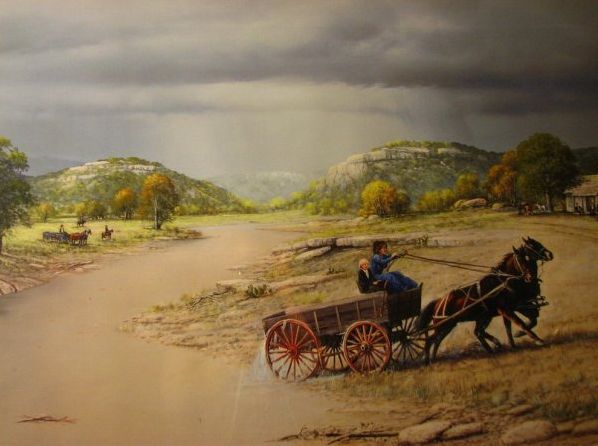
Dr. Charles William Bufkin
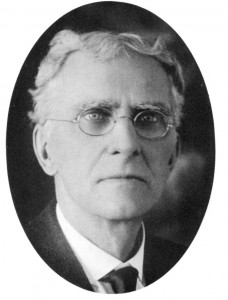 Dr. Charles William Bufkin was born on September 28, 1855. He graduated from the Medical College of Alabama in 1876. A year later, he opened his physician practice in Vossburg, MS. He did post-graduate work at the Bellevue Hospital Medical College in New York City in 1885 and 1886.
Dr. Charles William Bufkin was born on September 28, 1855. He graduated from the Medical College of Alabama in 1876. A year later, he opened his physician practice in Vossburg, MS. He did post-graduate work at the Bellevue Hospital Medical College in New York City in 1885 and 1886.
Charles married Corine Heidelberg in 1881 and together they had two girls, Lillie and Cannie. (At age four, Cannie died.)
The economy in the 1890s was in a depression and the medical profession in the south saw many doctors leave for bigger cities. This led to a shortage of doctors, especially in Hattiesburg, MS. The Bufkin family relocated to Hattiesburg.
By 1901, Dr. Charles William Bufkin was considered one of the best physicians in Hattiesburg, MS and his family physician practice was thriving. Along with two other doctors, he helped organize the first hospital in the Hattiesburg area in the early 1900s.
He suffered from an illness in 1918 and was forced to discontinue his practice for eight months. He resumed his pediatrics practice from his house on Main Street until he retired in 1924.
Dr. Bufkin died at the age of 72 in 1927. Corine Bufkin passed away four years later. Their daughter, Lillie, married James Sanford Love and gave birth to four children, including Eloise Elizabeth Love.
Dr. Charles William Bufkin is the great grandfather of Al Moore.
James Sanford Love
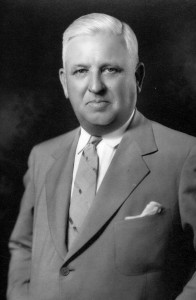 James Sanford Love was a successful businessman in Jackson, MS. His daughter, Eloise (Honey) Elizabeth Love, married William Alvin Moore, Sr.
James Sanford Love was a successful businessman in Jackson, MS. His daughter, Eloise (Honey) Elizabeth Love, married William Alvin Moore, Sr.
According to a biographical sketch published in December 1923,
“There is probably no man in the entire state of Mississippi who is better known in banking and financial circles than James Sanford Love of Greenwood, an authority on banking and finance, who was recently elected by the bankers of the state as the first superintendent of the state banks in Mississippi. Mr. Love began his career as a banker when he was a youth of some twenty summers, as a bookkepper in the Merchants & Farmers Bank of Macon, Mississippi.”
Read the full biographical sketch (.pdf)
In the 125th Anniversary issue (May 2014) of THE MISSISSIPPI BANKER, James S. Love was profiled and celebrated for leading Mississippi banks successfully through the Great Depression.
“No person had greater influence on the early development of state bank supervision in Mississippi than James Sanford Love. A country banker himself, Love served on the state’s first Board of Bank Examiners, and he became the first Mississippi Superintendent of Banks in from 1924 through 1934, seeing the state’s banking industry through the Great Depression.”
Read the full profile (.pdf)
In the Marty Hederman family book, Kirk G. Taylor writes about the success James Love experienced,
“The first day after his banking job terminated, on January 1, 1935, he organized J. S. Love Company, which was extremely successful in handling state, county, and municipal bonds during its forty years of operation. Howard Ivy, a friend who had worked for him during his bank superintendent days, helped organize the new company. He remarked, ‘Mr. Love was a perfect gentleman in every respect; he loved his fellowman; he was loyal to his friends; he was so very proud of his family and loved every one of them dearly.'”
Read the two-page biography (.pdf)
James Sanford Love is the grandfather of Al Moore.
Relatives in Wars
Burr Harrison
Born in 1738, Burr Harrison grew up in a rural county fifty miles outside of Cincinnati, Ohio. He married Elizabeth Dragon in 1768.
In 1776, Burr Harrison enlisted in the Continental Army and fought in the Revolutionary War. Records show he served as First Lieutenant in the Third Virgina Regiment. Records also show he fought at the Battle of Yorktown, the last major battle of the Revolutionary War.
After the war, Burr Harrison and his family settled in eastern Mississippi.
Burr Harrison is Al’s fourth great grandfather.
John Royall Love
Born about 1766, little is known about John Royall Love. He was married to Rachel (last name unknown) and they had one son, Milton Royall Love. During his teenage years, John fought in the Revolutionary War from the state of South Carolina.
John Royall Love is Al’s third great grandfather.
Samuel Shupe
Samuel Shupe was born 1799 in Reading, Pennsylvania. He moved to Texas in 1827 as a colonist in the Dewitt Colony, near Lockhart, TX. With the unrest between the Mexican government and the Texas settlers, Samuel volunteered to serve with the Texas militia.
Samuel fought at the Siege of Bexar in the fall of 1835 and the Texas militia defeated the Mexican army.
A few months later, the Battle of the Alamo and the Mexican army decimated the outnumbered Texas militia. Samuel did not fight in this battle.
The final conflict in the Texas Revolution took place at the Battle of San Jacinto on April 21, 1836. Shupe was at San Jacinto in the 5th Infantry Company, 2nd Regiment under Captain Thomas McIntire. The Texan militia surprise attacked the Mexican army at San Jacinto. It was hardly a contest, the Texas militia won easily. Texas fought for and won its independence from Mexico and the Republic of Texas was born.
Samuel Shupe and Patience Wells were married in July of 1838. They had two daughters together.
In 1847, Samuel Shupe became ill. He travelled to New Orleans for medical treatment but died en route due to his illness.
Samuel Shupe is Glenna’s second great grandfather.
Captain William B. Haygood
William B. Haygood owned a farm in Watkinsville, Georgia when he began serving in the Confederate Army in March of 1862. He was promoted to Captain on July 29, 1862.
Captain Haygood fought in the Battle of Sharpsburg (known as the Battle of Antietam in the north). He was wounded at Sharpsburg on September 17, 1862.
He later fought at Gettysburg on July 1, 1863. In that battle, Captain Haygood lost his right arm.
While traveling on a medical wagon to receive help for his wound, he was taken prisoner by the Union Army. Haygood was paroled on August 18, 1865 and he returned to civilian life in Athens, Georgia. He died on January 2, 1899 in Kirkland, Georgia.
William B. Haygood is Al’s second great grand uncle.
Davis Milton Love
Davis Milton Love, born 1842, fought in the Civil War in the Eleventh Mississippi Regiment with the “Noxubee Rifles.” Davis was wounded in battle. While he recuperated in Noxubee County, Davis married Mary Cockrell before returning to the war.
Davis Milton Love is Al’s great grandfather.
Charles Wesley Dollahite
James Calvin Dollahite
Charles Wesley Dollahite and James Calvin Dollahite both served in the Civil War. Charles was a Private-Corporal in the 36th Texas Cavalry, Company K, Woods’ Regiment. Charles Wesley made it through the Civil War but was killed by Comanche Indians.
Charles Wesley Dollahite is Glenna’s great grandfather.
James Calvin Dollahite is Glenna’s second great grand uncle.
Sergeant Harris H. Coffey
Harris H. Coffey, of Sulphur Springs, served as a bombardier in the US Army during World War II. While on a bombing mission over New Guinea in the South Pacific he was killed in action. He was just 23 years of age.
Harris H. Coffey is Glenna’s uncle.

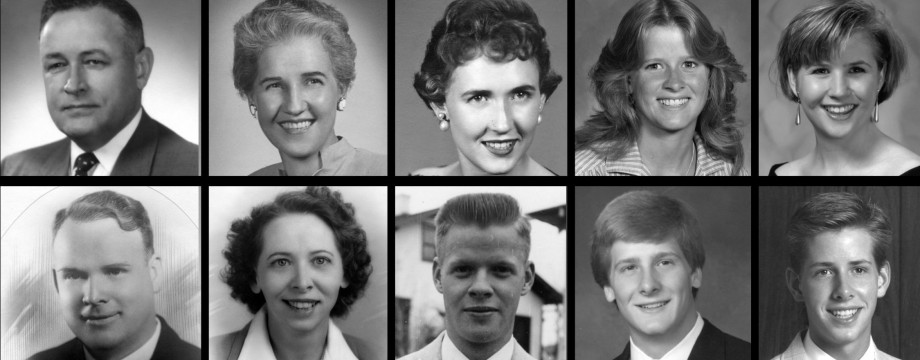
6 Responses to Long Ago Profiles